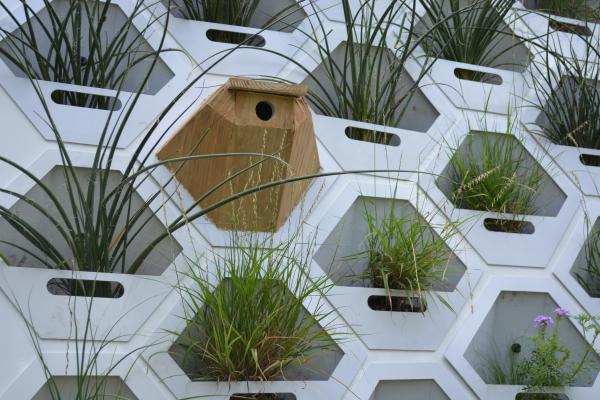Visit the Living Wall!

The School of Architecture's Living Wall is now up. Students from UTSOA and volunteers from the Lady Bird Johnson Wildflower Center recently installed a 10 x 25 foot living (or green) wall along the northwest corner of Goldsmith Hall. Comprised of native plants anchored in an innovative honeycomb structure, the living wall investigates the role of architecture in ecology, and underscores the university's commitment to green design. Partially funded by UT’s “Green Fee Award,” the project is five years in the making. Once realized, it will beautify the school, and will also serve as a bio-habitat on campus, in addition to providing other environmental benefits.
Initially conceived as a pilot-program by UT Vice President for University Operations Pat Clubb, the project was shepherded by UTSOA Dean Fritz Steiner and Assistant Professor Danelle Briscoe. Designs were informed by Mark Simmons “green roof” research. Simmons (now deceased) served as Director of Research and Consulting for the Ecosystem Design Group at the Wildflower Center. His work on the living wall was continued by Michelle Bright, an environmental designer at the Wildflower Center. Former Austin Councilman Chris Riley was an early advocate of the project and represented the city’s interest in the initiative as a collaborative endeavor. Matt Satter and Christian Klein, of Drophouse Designs, also contributed to the project by providing design assist services to Danelle Briscoe on the structure. They helped take the schematic design to construction documents as well as helping with the build and installation of the wall.
“This project represents the innovation and ingenuity of the School of Architecture faculty and that of our colleagues at the Lady Bird Johnson Wildflower Center,” remarked Dean Fritz Steiner. “The living wall will provide valuable data and insight into native flora, fauna, green design and sustainability. We are grateful to the University of Texas at Austin for their support of this project, and hope that our wall will be the first of many for our campus and community.”
Design
Installing a green wall in Austin, Texas represents a unique challenge. Similar projects are typically erected in forgiving climates, where plants can best thrive. A living wall in drought-prone Austin requires considerable thought and ingenuity. The project’s designers, for example, selected a cross-section of native plants (including succulents, shrubs, climbers, and grasses) that were not only visually striking, but also heat tolerant. To further ensure the wall’s success, they developed a honeycomb-shaped architectural structure, currently patent-pending. Its 148 “cells” (soil containers) were designed to accommodate a greater amount of dirt than is typically used—critical to sustaining the plants in Austin’s subtropical climate.
Bio-habitat
Another unique feature of the wall is that it has been designed to serve as a bio-habitat. The carefully-selected native plants were chosen to attract and provide shelter for anole lizards, hummingbirds, butterflies, songbirds, and raptors such as hawks and owls, among other beneficial fauna.
Environmental Benefits and Data Collection
Beyond its aesthetic and sociological benefits, the wall will provide building cooling, city cooling, storm water mitigation, noise buffering, and serve as a natural air filter, removing particulate matter, VOC’s and carbon monoxide as air passes through it. Given its location—facing highly-trafficked Guadalupe Street—the wall will undoubtedly spark dialogue, catalyzing multiple educational opportunities.
The wall at the School of Architecture will serve as a prototype for the project and its progress will be closely monitored. Data will be gathered and analyzed to determine if green walls can be implemented elsewhere on campus, and perhaps throughout the city of Austin
Discover more about the Living Wall in this video.

